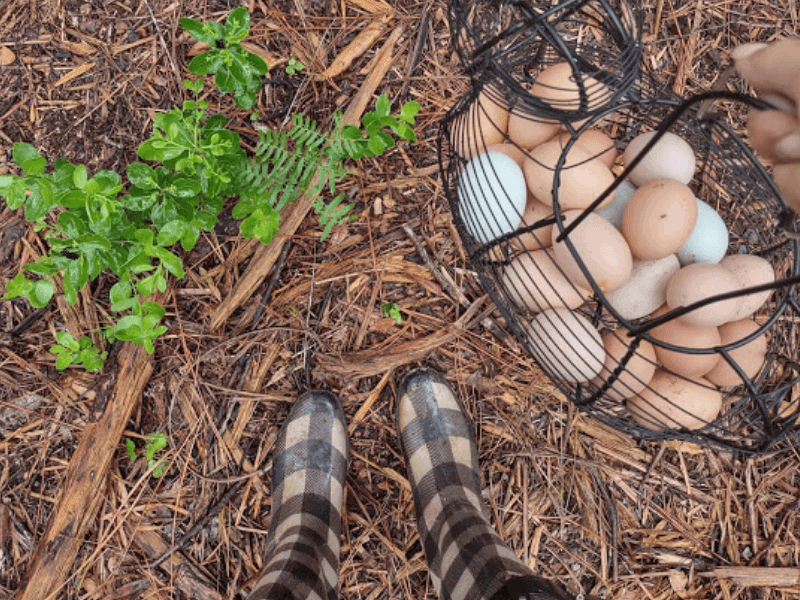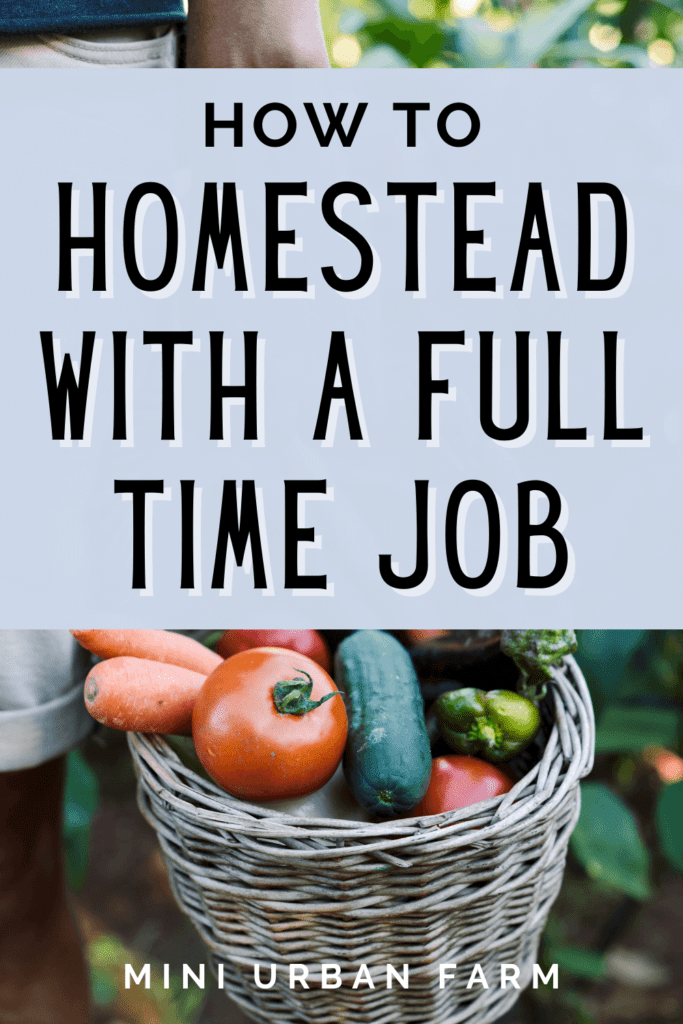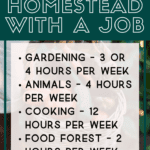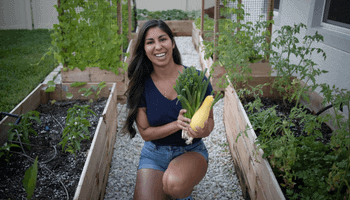An acquaintance came over to my house one day and we had an incubator in the kitchen – which is not uncommon at my house. Coincidentally, chicks were hatching that same day. Since we live in the suburbs, it’s not often you see newly hatched chicks. Let along get to see them hatch. After a while we went outside onto the patio and she was surprised by the “huge” garden on the side of the house And before I could even tell her that we actually grow all our own vegetables, she asked me…”Do you work?!” After she left, I did some research and it turns out “Can you homestead with a full time job?” is actually a pretty common question. My answer is, yes! Alan and I both work full time and we homestead in the suburbs!
Homesteading with a full time job:
- Gardening – 3 or 4 hours per week
- Animals – 4 hours per week
- Cooking – 12 hours per week
- Food Forest – 2 hours per week

Disclosure: This post may contain affiliate links. If you purchase a product through one of our affiliate links we make a small commission from the sale at no extra cost to our readers.
CAN YOU HOMESTEAD WITH A FULL-TIME JOB?
Homesteading with a full-time job may sound impossible to some. But it really comes down to the type of homestead you keep, and how much time you dedicate to each part.
Both Alan and I work 40 hour a week jobs, and still manage to have a social life and go out on the weekends.
So how do we do it?
Well, let’s talk about what homesteading actually means.
WHAT IS HOMESTEADING?
To “homestead” literally means to set up a home.
But when people talk about homesteading, they’re more referring to being self-sufficient and producing food and other basic goods that they need on that homestead.
And usually, this means you need a lot of space, right?
Actually, no.
You can homestead from pretty much anywhere by adapting basic homesteading principles – grow something you can eat, keep some sort of animals for food, eggs, or dairy, and try not to waste anything.
Of course, it gets a bit more complicated than that. So if you’re interested, check out these creative ways you can homestead in the suburbs (or an apartment, or the city).
But basically, incorporating these principles into your every day lifestyle is the key. And it’s not as difficult as it seems.
OUR HOMESTEAD
As an example, we call ourselves urban homesteaders.
We both have full time jobs outside of the house (although now we do work remotely since COVID hit)
Alan’s 2 daughters live with us part time.
We live in an HOA regulated community – our house is a typical suburban home. About 2200 square feet and a normal sized fenced-in backyard.
And we recently bought a 1.7 acre property about 10 minutes away from our home.
From the outside, you would never guess that all the vegetables we eat were grown in the backyard. And that I (often) butcher quail in the kitchen (or garage) sink.
We look like a pretty standard suburban family – white picket fence and all!
So now let’s break down the actual “homesteading” parts…
1. GARDENING
Many people grow gardens and don’t consider themselves homesteaders.
But since I’ve been gardening for 15+ years, this was the first step towards becoming more self-sufficient.
It happened gradually – seeing family members with major health problems because of the food they ate, hearing about weird stuff on the news due to pesticides on vegetables, and then (of course) not being able to buy food at the grocery store during the pandemic!
So once Alan and I moved in together, the natural next step was to set up a bigger garden so we can grow more food.
ABOUT MY GARDEN
Here are the quick facts about my actual gardening space – just in case you’re wondering how much space it really takes to do this.
- 450 square feet total – includes raised beds, containers, compost bin, and walkways
- 9 raised beds – 8 of them are 2×6 feet, one is 3×8 feet
- We put down landscape fabric to kill the weeds, then filled around the raised beds with crushed rock. You know, to make it pretty!
- Cost us about $750 to build the whole thing – but you could totally do it cheaper. Watch the whole breakdown in this video.
HOW MUCH TIME I SPEND GARDENING
This is a question I get asked a lot.
And the answer will definitely surprise you – because it surprised me when I did the math!
On average I spend about 3-4 hours per week in the garden.
And considering we don’t pay for vegetables or herbs at the store anymore, I think that’s a fair trade! I mean, most people spend wayyy more time than that just binging on Netflix every week.
These 3-4 hours vary depending on the week. Like if it’s the beginning or end of the season it’s usually more. And during the season it can actually be way less.
But here are the main gardening tasks that make up those hours:
- Daily garden walks to check on the garden
- Pest control and prevention
- Watering my plants and checking on the drip irrigation system
- Harvesting veggies and herbs – for dinner or to preserve for later
For a full list of daily, weekly, and season garden chores check out this post.
2. ANIMALS
We got into chickens on a whim – which is definitely not the way I recommend that you start!
Walking through Tractor Supply one day, Alan saw the newborn baby chicks. And next thing I knew we had 3 chickens in the garage!
If you’ve ever had chickens, then you know it’s impossible to have only 3 chickens. Fast forward a year later and we’re close to 50!
But before we go any further, no – we don’t keep them in the garage!
Since we live in an HOA community, we can’t actually keep chickens at home. But thankfully we own another property about 10 minutes away where we have a chicken coop. Well, multiple chicken coops at this point.
If you live in a neighborhood without chicken restrictions, backyard chickens are a great idea. And I even have some amazing urban chicken keeping tips for you!
ABOUT OUR ANIMALS
- We keep Plymouth Barred Rock (which is one of my favorite dual-purpose chicken breeds) as well as some colored egg layers.
- We raise chickens for both meat and eggs (we use the eggs for eating and to hatch out more chickens for meat)
- The meat chickens are in a chicken tractor that gets moved every few days
- We also have about 12 quail which we will breed out to make new quail.
- Our quail will be for meat, eggs, and dog food.
- Eventually we will have turkey, goats, bees, and maybe even pigs and sheep!
HOW MUCH TIME I SPEND WITH THE ANIMALS
On any given week we spend about 4 hours looking after the animals. Which for right now includes our chicken and quail.
But keep in mind that this also accounts for the time commuting back and forth to the property. As well as buying their feed at the grocery store.
So every other day (sometimes more) we head over the the property after work and let the chickens free range. Not only does this make their eggs better, but it gives me a chance to do the animal chores.
Our animal chores include:
- Checking on the animals food and water
- Refilling the feed as needed
- Fixing the rain barrel system as needed
- Moving the chicken tractor
- Making sure they are in good health
- Making sure the chickens are in their coops every night
- Buying the feed at the store
Overall, 4 hours may seem like a lot of time during the week to take care of the animals. But keep in mind that we don’t buy eggs anymore. And we still have chicken in the freezer from our last meat chicken batch.
Plus, much of this time is actually spent in the hammock watching the chickens. Or making chicken videos for our YouTube channel.
3. COOKING
A major of our homestead chores is cooking. And this one actually does take up quite a bit of time on a daily basis.
After all, it is on my list of daily homesteading tasks.
So basically I cook the majority of our meals. Either by actually cooking from scratch, by meal prepping in bulk and the beginning of the week, or by using our preserved items to prepare dinner.
Also, every Friday in our home is “Veronica is not cooking night” so I didn’t include that in this breakdown.
And we don’t buy prepackaged foods. Mostly for health reasons – but also because it’s cheaper to cook and tastes way better.
It does help that I love to cook. But if you’re struggling with this one, nothing gets me in the mood for cooking like pouring a glass of red and playing my cooking playlist on Alexa!
COOKING FROM SCRATCH DETAILS
- I cook almost every meal – breakfast, lunch, and dinner. Except on Friday nights (remember “Veronica is not cooking night”?) and Saturday nights when we go to my grandmother’s house for dinner
- It takes me anywhere from 20 minutes to over an hour to make each meal
- I cook using mostly things from the garden – because have you seen the price of herbs?!
- I hardly ever stick to a recipe – even though I love my cooking books I just use the recipe as a base and then add on from there
- The kids love helping me cook. And when they’re done, their chore is to set the table for dinner
- We almost never get take out, and when we do go out to eat we make sure it’s not fast food.
HOW MUCH TIME I SPEND COOKING
On average I spend about 12 hours per week cooking. Which has just become a part of daily life.
This includes things like:
- Cooking each meal from scratch
- Bulk prepping lunch for the week (sometimes I make a pot of beans or soup)
- Making pasta dough for the week
- Making bread at the beginning of the week
- Preserving food from the garden for later
Basically we have a routine in our family. So each day we take something out of the freezer to defrost for later. After work we head to the store, go check on the animals, go run errands, etc.
Then at about 6:30 or 7 in the evening, I start cooking.
Same goes for the morning – after I workout, take the dog out, check my emails, I make breakfast.
For lunch we either have left overs, eat something that I prepared for the week (like garbanzos), or I whip something up in under 20 minutes.
4. FOOD FOREST
Since we are currently in the process of building out our food forest, we do spend some time on this activity every week.
And this was actually one of our main priorities when we bought our property.
I wanted to have a food growing space that was self-sustaining and required little input from me. You know, once it’s established.
In the meantime though we do spend a fair bit of time trying to get it established and making sure it’s growing.
We have already started planting some fruit trees, but mostly we spend time making sure the space is cleared and ready for planting.
DETAILS ABOUT OUR FOOD FOREST
- We have dedicated about 7000 square feet of space to the food forest
- We’ve started removing pine trees that were there and mulched the entire space
- Our chicken tractor gets moved throughout this space so that the chickens can help us clear the land – plus free chicken food!
- We currently have 5 fruit trees growing – guava, soursop, mango, fig, and orange
- Once we clear the whole thing and fence it in we will start adding other lower level plants and crops
HOW MUCH TIME I SPEND ON THE FOOD FOREST
Usually we take care of the food forest when we’re already on the property to check on the chickens. Which is either after work or on the weekends.
So about 2 hours per week gets dedicated to the food forest.
This includes things like:
- Clearing the land – either taking down trees or moving the chicken tractor
- Buying and planting the fruit trees
- Making sure that our chickens don’t eat the fruit trees – ie netting around the trees
- Doing research on the best plants and trees to plant
Now, this time commitment varies since after a while we won’t need to take down anymore trees and sometimes we don’t have any trees to plant.
But for now, we are working to get it established. And hopefully after it’s all done there will be little to no maintenance for this part of the homestead.
HOMESTEADING SYSTEMS I PUT IN PLACE
Having different systems in place allows me to focus on other things – like spending time with my family. Instead of slaving away over the homestead. Which makes it possible to homestead with a full time job!
If you can, I definitely encourage you to set up some of these systems. And of course, only focus on one at a time!
- Drip irrigation in the garden – once this is set up you won’t need to spend time watering your plants! I would still recommend you check on the plants though – it’s super easy to over water your garden on a drip system! This is how I set up my system.
- Rainwater collection – On our property there’s actually no well. Which means we need to find a different way to give water to our chickens. So we set up a rain water system off the roof of the chicken coop.
- Automatic chicken waterer – this actually feeds off of the rainwater barrel and allows our chickens to drink out of the barrel. Such a lifesaver when it comes to watering the chickens! Plus it prevents their water from getting dirty which prevents them from getting sick!
- Giant chicken feeder – we actually used a trash can to make a huge feeder which holds 185 pounds of chicken feed. This prevents me from having to feed them on a daily basis. You can watch how we made it in this video.
- Automatic egg turner in the incubator – okay so this isn’t really a system. But it kind of is! When you incubate eggs you have to turn them every 4 hours. So instead of wasting my time doing that, I bought an automatic egg turner to do it for me!
- Food forest – This is a system in the making. For now, it actually consumes our time. But in the long run, this mini ecosystem will self-regulate and give us a never ending supply of food!
TIPS FOR HOMESTEADING WITH A FULL-TIME JOB
- Get the kids involved. We involve the kids in everything we do from feeding the chickens to cooking and they enjoy helping out.
- Put systems in place to help you reduce the burden of having to work on the chores yourself. It gives you more time to do other homesteading duties (or just relax!)
- Cook in bulk. It really does do wonders to make meals in bulk. It takes the thought out of what to make and saves you time on a daily basis!
- Create a routine. If you have a full-time job, it may not be possible to rush home during your lunch break to check on your garden, animals, or even cook bulk meals. Setting and following a routine can help you manage your time and ensure you have taken care of every part of your homestead.
the best homesteading books for urban homesteaders
- The Backyard Homestead – everything you need to know about growing your own food on a normal suburban plot
- The Complete Beginner’s Guide to Raising Small Animals – perfect for raising livestock in a small space
- Back to Basics – a great book to learn traditional homesteading skills
- Mini Farming – perfect for becoming self-sufficient in the suburbs
- Raised Bed Gardening for Beginners – everything you need to learn how to garden in raised beds
- The Weekend Homesteader – 12 month guide to self-sufficiency
- Beekeeping for Beginners – learn to keep bees in the suburbs
The bottom line is that it’s totally possible to homestead with a full time job!
Like they say, if there’s a will, there’s a way. And by implementing some of the things in this post I hope you find a way that works for your homestead!
PIN HOW TO HOMESTEAD WITH A FULL TIME JOB!









